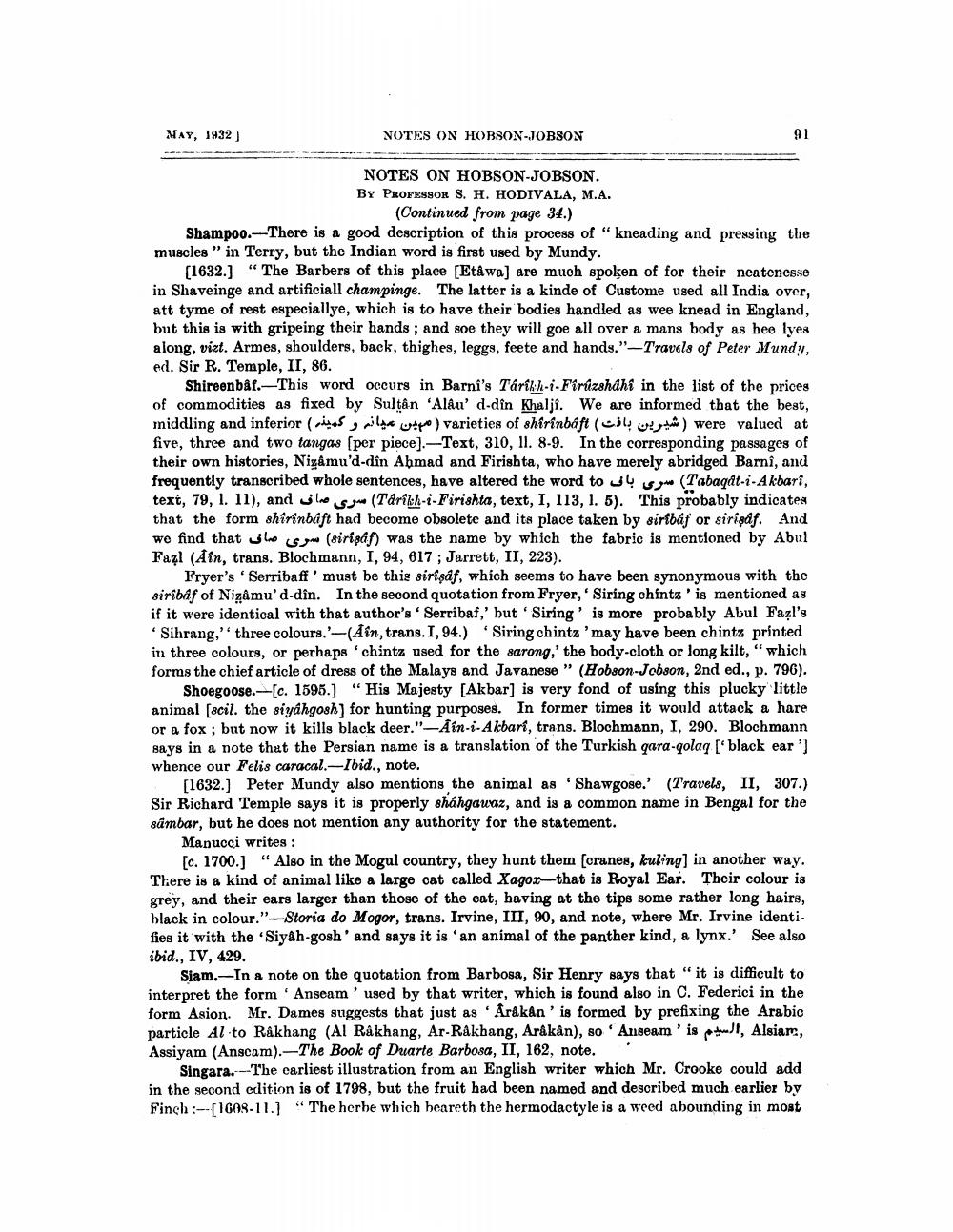________________
MAY, 1932)
NOTES ON HOBSON-JOBSON
--
NOTES ON HOBSON-JOBSON. BY PROFESSOR S. H. HODIVALA, M.A.
(Continued from page 34.) Shampoo.There is a good description of this process of "kneading and pressing the muscles" in Terry, but the Indian word is first used by Mundy.
[1632.) "The Barbers of this place [Etawa) are much spoken of for their neatenesse in Shaveinge and artificiall champinge. The latter is a kinde of Custome used all India over, att tyme of rest especiallye, which is to have their bodies handled as wee knead in England, but this is with gripeing their hands; and soe they will goe all over a mans body as hee lyes along, vizt. Armes, shoulders, back, thighes, leggs, feete and hands."-Travels of Peter Mundy, ed. Sir R. Temple, II, 86.
Shireenbåf.—This word occurs in Barni's Tarih:h-i-Firúzsháhi in the list of the prices of commodities as fixed by Sultân 'Alau'd-din Khaljî. We are informed that the best,
were valued at ( شیرین بافت ) varieties of shtrinbaft ( مین میانه و کمینه ) Iniddling and inferior
five, three and two tangas (per piece. Text, 310, II. 8-9. In the corresponding passages of their own histories, Nizâmu'd-din Ahmad and Firishta, who have merely abridged Barnî, and frequently transcribed whole sentences, have altered the word to J (Tabaqdt-i-Akbari, text, 79, 1. 11), and wil sy (Tarikh-i-Firishta, text, I, 113, 1. 5). This probably indicates that the form shirinbaft had become obsolete and its place taken by sirfbáf or siriadf. And we find that he is you (sirisåf) was the name by which the fabric is mentioned by Abul Fazl (Ain, trans. Blochmann, I, 94, 617; Jarrett, II, 223).
Fryer's Serribaff' must be this sirişaf, which seems to have been synonymous with the siribáf of Nizâmu'd-dîn. In the second quotation from Fryer, Siring chintz' is mentioned as if it were identical with that author's 'Serribaf,' hut Siring' is more probably Abul Fazl's
Sihrang, three colours,'-(Ain, trans. I, 94.) Siring chintz 'may have been chintz printed in three colours, or perhaps chintz used for the sarong,' the body-cloth or long kilt, "which forms the chief article of dress of the Malays and Javanese " (Hobson-Jobson, 2nd ed., p. 796).
Shoegoose.--[c. 1595.) "His Majesty [Akbar] is very fond of using this plucky little animal (scil. the siyahgosh) for hunting purposes. In former times it would attack a hare or a fox; but now it kills black deer."-Āin-i-Akbari, trans. Blochmann, I, 290. Blochmann says in a note that the Persian name is a translation of the Turkish qara-qolag ['black ear') whence our Felis caracal.-Ibid., note.
[1632.] Peter Mundy also mentions the animal as Shawgose.' (Travels, II, 307.) Sir Richard Temple says it is properly shahgauaz, and is a common name in Bengal for the sámbar, but he does not mention any authority for the statement.
Manucci writes :
[c. 1700.] “Also in the Mogul country, they hunt them (oranes, kuling) in another way. There is a kind of animal like a large cat called Xagox-that is Royal Ear. Their colour is grey, and their ears larger than those of the cat, having at the tips some rather long hairs, black in colour."-Storia do Mogor, trans. Irvine, III, 90, and note, where Mr. Irvine identi. fies it with the 'Siyah-gosh' and says it is an animal of the panther kind, a lynx.' See also ibid., IV, 429.
Siam.-In a note on the quotation from Barbosa, Sir Henry says that "it is difficult to interpret the form 'Anseam' used by that writer, which is found also in C. Federici in the form Asion. Mr. Dames suggests that just as 'Arakan' is formed by prefixing the Arabic particle Alto Rakhang (Al Rakhang, Ar-Rakbang, Arâkân), so'Anseam' is I, Alsiam, Assiyam (Anscam).-The Book of Duarte Barbosa, II, 162, note.
Singara.---The carliest illustration from an English writer which Mr. Crooke could add in the second edition is of 1798, but the fruit had been named and described much earlier by Finch :-[1608-11.1 * The herbe which beareth the hermodactyle is a weed abounding in most




